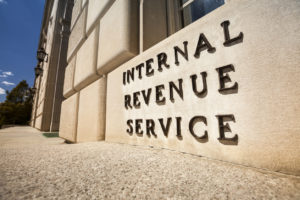Constructive receipt is a fundamental tax concept that can have a broad and frightening impact. According to the IRS, you have income for tax purposes when you have an unqualified, vested right to receive it. Asking for payment later does not change that. Childs v. Comm’r, 103 T.C. 634, 654 (1994), aff’d, 89 F.3d 856 (11th Cir. 1996). The idea is to prevent taxpayers from deliberately manipulating their income. The classic example is a bonus check available in December that an employee asks to be withheld until January 1. Normal cash accounting suggests that the bonus is not income until paid; however, the employer tried to pay the bonus in December and made the check available, making it income in December even though it is not collected until January.
Cash v. Accrual Accounting
Constructive receipt is an issue only for cash method taxpayers like individuals. Constructive receipt is built into the accrual method (used by most large corporations), under which you have income when all events occur that fix your right, if the amount can be determined with reasonable accuracy. Treas. Reg. §§ 1.446-1(c)(1)(ii), 1.451-1(a). Thus, you book income in accrual accounting when you send out an invoice, not when you collect it. Rev. Rul. 84-31, 1984-1 C.B. 127. For cash method taxpayers, however, the IRS worries about “pay me later” shenanigans. The tax regulations provide that a taxpayer has constructive receipt when income is credited to the taxpayer’s account, set apart, or otherwise made available to be drawn upon. See Treas. Reg. § 1.451-2.
Effect of Restrictions
On the other hand, there is no constructive receipt if your control is subject to substantial limitations or restrictions. There is considerable debate over what substantial limitations or restrictions prevent constructive receipt. For example, what if an employer cuts a check on December 31 but tells its employee to either drive 60 miles to pick it up or wait for its arrival in the mail? The employer may book this as a December payment (and issue a Form W-2 or 1099 that way), but the employee may have a legitimate position that it is not income until received. Such mismatches occur frequently, and there is little to suggest that there is manipulation going on.
Legal Rights
Whether they know it or not, lawyers deal with constructive receipt issues frequently. Suppose a client agrees orally to settle a case in December, but specifies that the settlement be paid in January. When is the amount taxable? In January. The mere fact that the client could have agreed to take the settlement in Year 1 does not mean the client has constructive receipt.
The client holds legal rights and is free to condition his or her agreement (and the execution of a settlement agreement) on the payment in Year 2. The key is what the settlement provided before it was signed. If you sign the settlement agreement and condition the settlement on payment next year, there is no constructive receipt. On the other hand, if you sign first and then ask for a delayed payment, you have constructive receipt. In much the same way, you are free to sell your house and to insist on receiving installment payments, even though the buyer is willing to pay cash. However, if your purchase agreement specifies you are to receive cash, then it is too late to change the deal and say you want payments over time. The legal rights in the documents are important.
Lawyer Trust Accounts
If a case settles and funds are paid to the plaintiff’s lawyer trust account, it usually is too late to structure the plaintiff’s payments. Even though the plaintiff may not have actually received the money, the lawyer has. For tax purposes, a lawyer is the agent of his or her client, so there is constructive (if not actual) receipt.
Consider the impact of disputes between lawyer and client. Suppose that Larry Lawyer and Claudia Client have a contingent-fee agreement calling for Larry to represent Claudia in a contract dispute. If Larry succeeds and collects, the fee agreement provides that Claudia receives two-thirds, and Larry retains one-third as his fee. Before effecting the one-third/two-thirds split, however, costs are to be deducted from the gross recovery.
Suppose that Larry and Claudia succeed in recovering $1 million in September of 2016. Before receiving that money, however, Larry and Claudia become embroiled in a dispute over the costs ($50,000) and the appropriate fee. Larry and Claudia agree that $25,000 in costs should first be deducted, but Claudia claims that the other $25,000 in costs is unreasonable and should be borne solely by Larry. Furthermore, Claudia asserts that a one-third fee is unreasonable, and that the most she is willing to pay is 20 percent. Larry and Claudia try to resolve their differences but cannot do so by the end of 2016. In January 2017, the $1 million remains in Larry’s law firm trust account. What income must Larry and Claudia report in 2016?
Undisputed Amounts
Arguably, there is a great deal that is not disputed. Larry and Claudia have agreed that $25,000 in costs can be recouped and that Larry is entitled to at least a 20-percent fee, although it is not yet clear if that 20-percent fee should be computed on $950,000 or on $975,000. Nevertheless, Larry is entitled to at least $25,000 in costs and to at least a $190,000 fee, for a total income of $215,000. Although it is not yet clear how much Claudia will net from the case, the minimum she will get is specified in the provisions in the fee agreement. Thus, taking the $50,000 as costs, Claudia should receive two-thirds of $950,000, or $633,270. Even under Larry’s reading of the fee agreement, this is the amount to which Claudia is entitled, although she might receive more if her arguments prevail.
How much should Larry and Claudia report as income? You might think that you do not have enough information to make that decision, and you would probably be right. After all, you do not really know whether Larry and Claudia have agreed that partial distributions can be made, or if they are taking the position that they will not agree to anything unless the entire matter is resolved. However, that does not appear to be so. Indeed, the positions of the parties seem clear that each is already entitled to some money. That gives rise to income, regardless of whether they actually receive the cash. If they have a legal right to the money and could withdraw it, then that is constructive receipt, if not actual receipt.
Any talk of withdrawal should invite discussion of restrictions and partial agreements. For example, what if you add to the fact pattern that, although these are the negotiating positions of Larry and Claudia, neither of them will agree to any distributions, treating the entire amount as disputed. Does that mean neither has any income in 2016? Does it matter what documents are prepared? The answer to the latter question is surely “yes.” Good documentation always goes a long way to helping to achieve tax goals.
For example, an escrow agreement acknowledging that all of the money is in dispute and prohibiting any withdrawal until the parties agree might contraindicate income. A document each party signs agreeing that they disagree and that no party can withdraw any amount until they both agree in writing should be pretty convincing. Even so, I am not sure it is dispositive to the IRS. It may be hard to argue with the fact that the parties’ positions speak for themselves, and that some portions of the funds are undisputed. Besides, there is a strong sentiment that a lawyer is merely the client’s agent. Presumptively, settlement monies in the hands of the lawyer are already received by the client for tax purposes.
Consider the defendant in this example. The defendant paid the $1 million in 2016. Depending on the nature of the payment, it seems reasonable to assume that the defendant will deduct it in 2016. It will likely issue one or more IRS Forms 1099, too, probably to both Larry and Claudia in the full amount of $1 million each. How will Larry and Claudia treat those Forms 1099? There may be a variety of possibilities. Assuming both Larry and Claudia argue the entire amount is in dispute, one approach is to footnote Form 1040, line 21 (the “other income” line), showing the $1 million payment. Then, they might subtract the $1 million payment as disputed and in escrow and therefore not income, netting zero on line 21. There is probably no perfect way to do this.
Escrows and Qualified Settlement Funds
Apart from mere escrows, qualified settlement funds (sometimes called QSFs or a 468B trusts) are also increasingly common. A QSF typically is established by a court order and remains subject to the court’s continuing jurisdiction. Treas. Reg. § 1.468B-1(c)(1). If the fund is a QSF, the defendant would be entitled to its tax deduction, yet neither Larry nor Claudia would be taxed on the fund’s earnings. The fund itself would be taxed, but only on the earnings on the $1 million, not the $1 million itself.
In our example, there is no court supervision, so it seems unlikely that the escrow could be a QSF. If the fund is merely an escrow, either Larry or Claudia should be taxed on the earnings in the fund, but not on the principal until the dispute is resolved and the disputed amount is distributed. Unlike a QSF, escrow accounts typically are not separately taxable, so one of the parties must be taxed on the earnings. See Treas. Reg. §§ 1.468B-6, 1.468B-7.
Normally, the escrow’s earnings would be taxable to the beneficial owner of the funds held in escrow. Rev. Rul. 77-85, 1977-1 C.B. 12 (IRB 1977), modified on other grounds, IRS Announcement 77-102 (1977). Either Larry or Claudia (or both) could be viewed as beneficial owners. Therefore, an agreement specifying who will be taxed on the disputed funds while held in escrow would be wise.
Structured Settlements and Structured Legal Fees
Some clients prefer structured settlements that pay them (through the use of annuities) over time rather than in a lump sum. In a similar way, contingent-fee lawyers who expect to receive a contingent fee are allowed to “structure” their fees over time, but if they receive the funds in their trust account, it is too late to structure. In fact, it is too late to structure fees if the settlement agreement is signed and the fees are payable. A lawyer who wants to structure legal fees must put the documents in place before the settlement agreement is signed. Just as in the case of the plaintiff, legal rights are at stake. In general, a contingent-fee lawyer is entitled to condition his or her agreement on a payment over time.
In reality, of course, it is the client of the plaintiff’s lawyer that has the legal rights and is signing the settlement agreement. That is why a lawyer who wants to structure fees must build that concept into the settlement agreement. Like structured settlements for plaintiffs, legal fee structures usually are not installment payments by the defendant. Rather, the settlement agreement will specify the stream of payments and call for the contingent fee to be paid to a third party that makes those arrangements. As you might expect, it is important for each element of the legal fee structure to be done carefully to avoid the lawyer being taxed before he or she receives installments, but the entire concept of structured legal fees must be mindful of the constructive receipt doctrine.
Understandably, cash method taxpayers do not want to be taxed on monies before they actually receive them; however, the constructive receipt doctrine can upset this expectation. Constructive receipt often can be avoided through careful planning and proper documentation.
More About Qualified Settlement Funds
The rules pertaining to constructive receipt seem to be thrown out the window when using this important and innovative settlement device. A QSF typically is set up as a case is resolved. The IRS provides that a fund is a “qualified settlement fund” if it satisfies each of the following:
- It is established pursuant to an order of, or is approved by, specified governmental entities (including courts) and is subject to the continuing jurisdiction of that entity;
- It is established to resolve or satisfy one or more claims that have resulted or may result from an event that has occurred and that has given rise to at least one claim asserting certain liabilities; and
- The fund, account, or trust must be a trust under applicable state law, or its assets must otherwise be segregated from other assets of the transferor. Treas. Reg. § 1.468B-1(c).
Section 468B trusts allow defendants to pay money into the trust and be entirely released from liability in a case, yet the plaintiffs and their counsel do not have income until the money comes out. The 468B trust is a kind of holding pattern where no one is (yet) taxed on the principal or corpus of the trust. Even so, the defendant can deduct the payment for tax purposes. Any interest earned on the monies in the QSF is taxed to the trust itself. There are many nuances to observe about the use of QSFs.
However, QSFs can be a kind of safety valve from the constructive receipt doctrine. In appropriate cases, QSFs can provide lawyers and clients with additional time to sort out who is entitled to what, to resolve liens, and to arrange for structured settlements and structured legal fees. A QSF allows plaintiffs and their lawyers to resolve such issues after the defendant(s) have paid the settlement or judgment but before the plaintiffs and their lawyers have receipt.
Conclusion
Constructive receipt is a fundamental, yet widely confused, tax doctrine. It applies when you have an unrestricted right to income but you do not accept it. Consequently, lawyers and their clients may encounter constructive receipt concerns if they sign legal releases or are otherwise entitled to payments that they then try to delay. Be careful. A good rule of thumb is not to sign a settlement agreement unless: (1) you are clear on what the timing of the payments will be; and (2) this timing is acceptable to you. Once you (or your client) signs and is entitled to payment, it may be too late to change it. In some litigation, one way to build in payment flexibility can be by using a QSF that holds the funds. A QSF can be especially appropriate in complex cases with multiple parties involving disputes over payment amounts and timing. However you address these issues, no one wants to be taxed on money they have not even received!

















